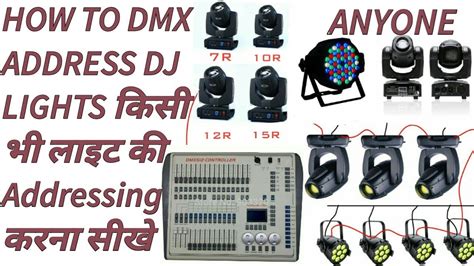DMX Addressing: Simple Steps for Beginners
DMX512, or Digital Multiplex, is the industry standard for controlling stage lighting and other theatrical effects. While it might seem intimidating at first, understanding DMX addressing is surprisingly straightforward. This guide breaks down the process into simple, easy-to-follow steps, perfect for beginners. We'll cover the basics, answer common questions, and get you started on controlling your lighting with confidence.
What is DMX Addressing?
Before diving into the steps, let's clarify what DMX addressing actually is. Each lighting fixture (or other DMX-controlled device) needs a unique address to receive commands. Think of it like assigning a specific channel to each light. DMX uses a sequence of numbers, typically from 1 to 512, to identify each device. Without proper addressing, your lights might not respond correctly, or even worse, conflict with each other.
Step-by-Step Guide to DMX Addressing
Here's a simple, step-by-step guide to addressing your DMX fixtures:
Step 1: Identify Your Fixtures and Their Requirements
Before you start, carefully examine your lighting fixtures. Each fixture's manual will specify the number of DMX channels it requires. For example, a simple PAR can may only use 1 channel for intensity, while a moving head might require 16 or more channels to control pan, tilt, color, gobo, and other effects.
Step 2: Plan Your Addressing Scheme
With the channel requirements for each fixture known, create a plan. This involves deciding which address each fixture will receive. Start with address 1 and incrementally add the number of channels each fixture uses. For example:
- Fixture 1 (1 channel): Address 1
- Fixture 2 (3 channels): Address 2-4
- Fixture 3 (1 channel): Address 5
- Fixture 4 (16 channels): Address 6-21
Important: Ensure there are no overlapping addresses. Each channel number must be unique.
Step 3: Access the Addressing Menu on Your Fixtures
Most fixtures have a physical display and buttons or a menu system accessible via DMX control software. Consult your fixture's manual to find the specific instructions for accessing the addressing settings. This often involves using dip switches, rotary encoders, or a dedicated menu within the fixture's interface.
Step 4: Set the Address
Using the fixture's controls, input the address you've assigned in Step 2. Remember to double-check the address before moving on to the next fixture to prevent conflicts.
Step 5: Test Your Addressing
Once all fixtures are addressed, test your setup using a DMX controller. Send test signals to each fixture to verify that they are responding correctly to their assigned addresses. If a fixture isn't reacting, double-check the address and wiring.
Common Questions about DMX Addressing
What happens if I use the same address for two fixtures?
If two or more fixtures share the same address, they will conflict. One or both may not function correctly, potentially causing unpredictable behavior and potentially damaging equipment. Always ensure unique addresses for each fixture.
Can I use a DMX controller to address my fixtures?
Some DMX controllers allow for setting addresses directly from the controller. However, many controllers require fixtures to be pre-addressed before being controlled. Check your controller's manual for specific instructions.
How many channels can I use in a single DMX universe?
A standard DMX universe supports 512 channels. If you need more than 512 channels, you'll require additional DMX universes and potentially a DMX merger.
What if I make a mistake in addressing my fixtures?
Simply repeat steps 3 and 4 to correct the address. Many fixtures allow for quick and easy address changes.
What are DMX splitters and mergers?
DMX splitters allow you to send the same signal to multiple controllers or devices, whilst DMX mergers combine multiple DMX universes into a single output. These are often necessary for larger setups requiring more than 512 channels.
By following these simple steps and understanding the basics, you'll be well on your way to mastering DMX addressing and creating impressive lighting designs. Remember to always consult your fixture manuals for specific instructions and safety precautions. Happy lighting!

